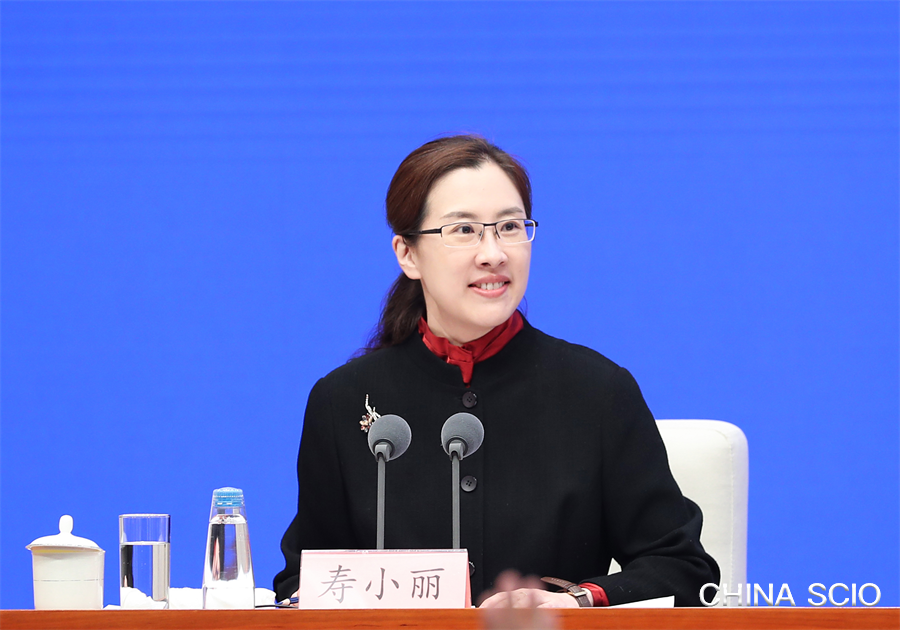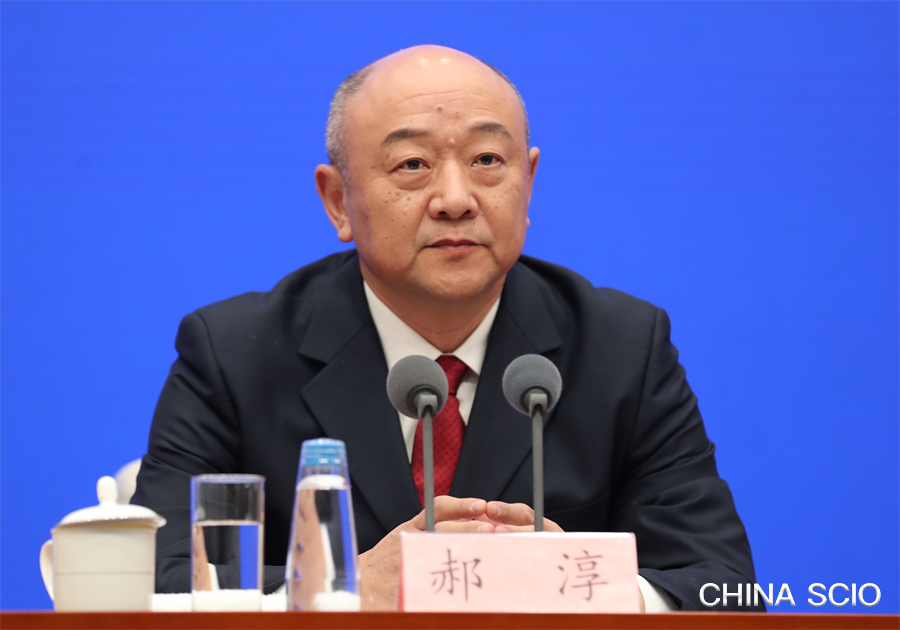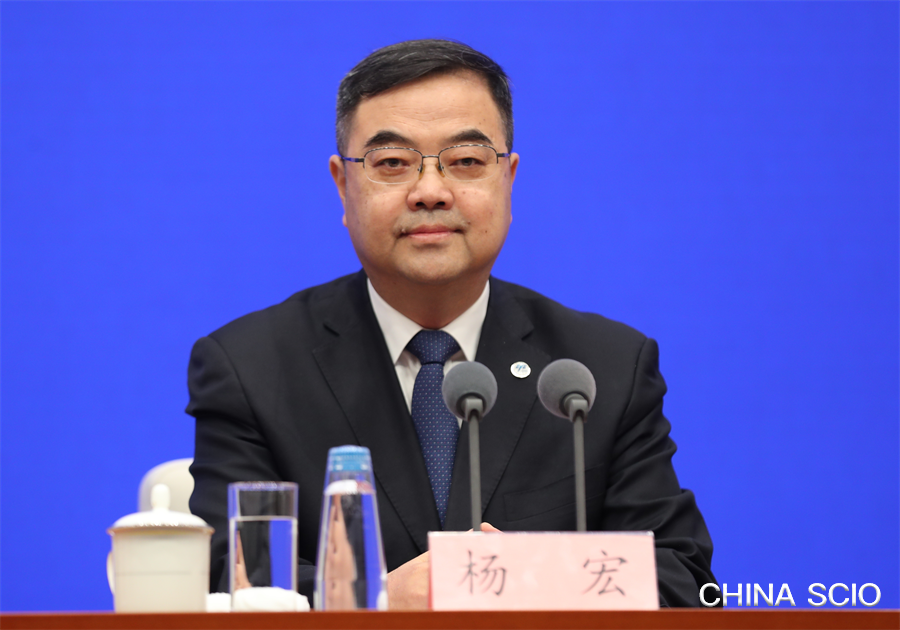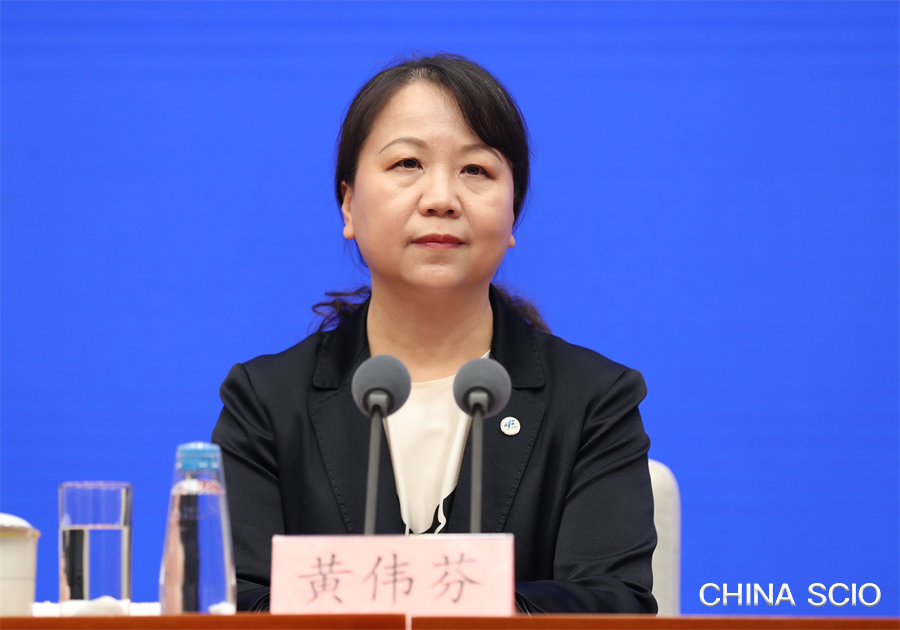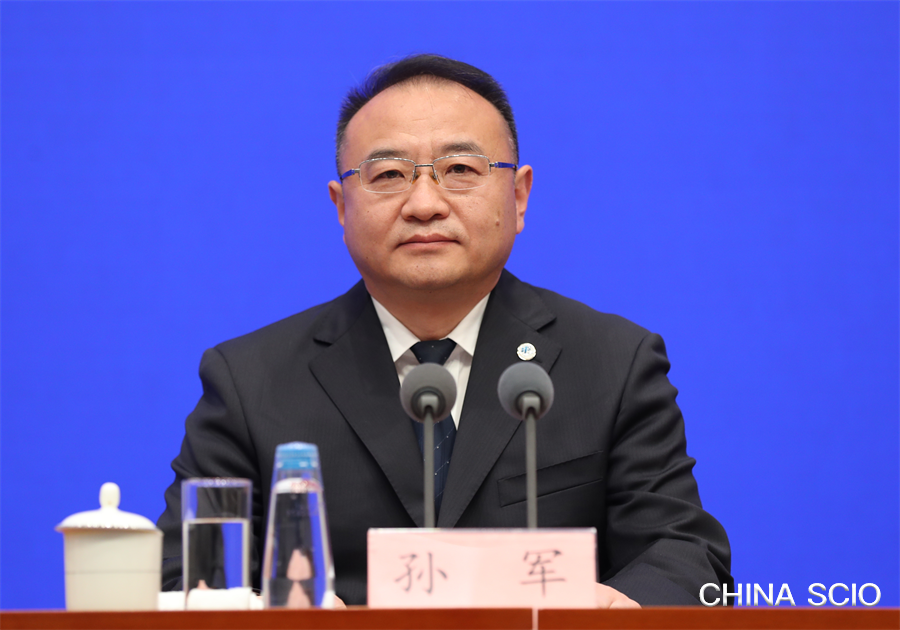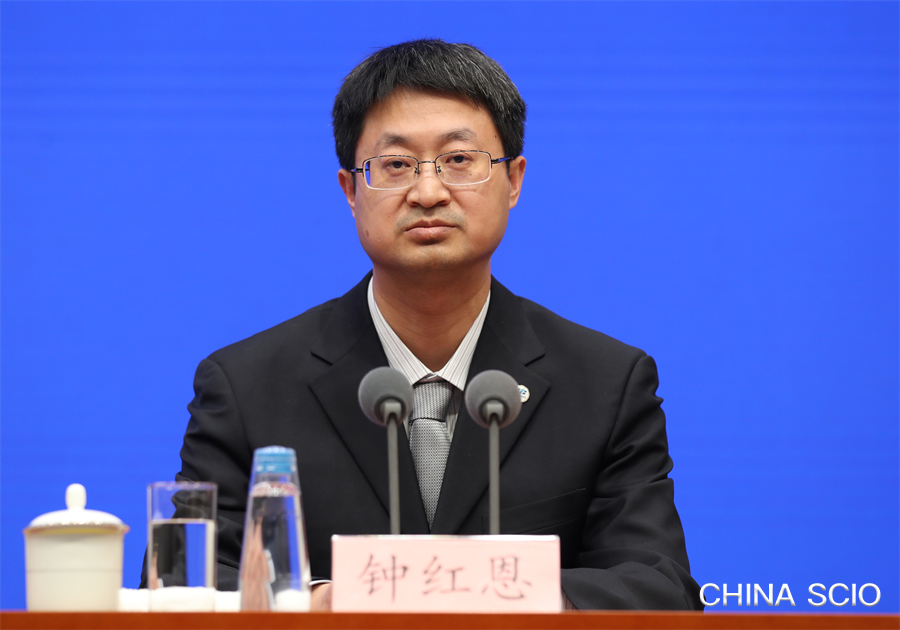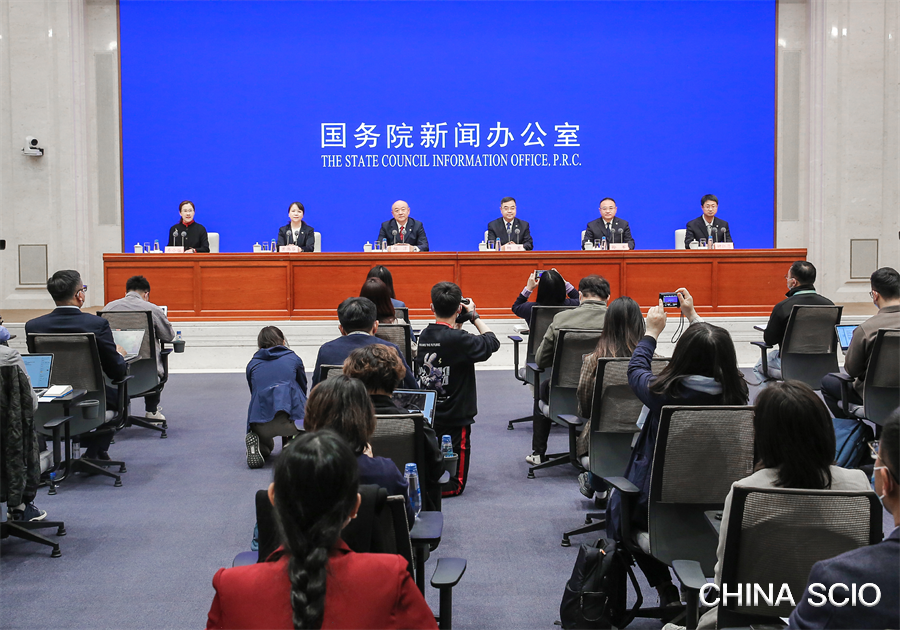.
Read in Chinese
Speakers:
Hao Chun, director general of the China Manned Space Agency
Yang Hong, academician of the Chinese Academy of Engineering, chief designer of the space station system of the China Manned Space Program (CMSP), and researcher at the China Academy of Space Technology
Huang Weifen, chief designer of the astronaut system of the CMSP and researcher at the China Astronaut Research and Training Center
Sun Jun, chief designer of the space station mission at the Beijing Aerospace Control Center
Zhong Hong'en, deputy chief designer of the space utilization system of the CMSP and researcher at the Technology and Engineering Center for Space Utilization of the Chinese Academy of Sciences
Chairperson:
Shou Xiaoli, deputy director general of the Press Bureau of the State Council Information Office (SCIO) and spokesperson of the SCIO
Date:
April 17, 2022
Shou Xiaoli:
Ladies and gentlemen, good afternoon. Welcome to this press conference held by the State Council Information Office (SCIO). Yesterday, Shenzhou-13's return capsule touched down safely, marking the complete success of the Shenzhou-13 manned mission. Today, we are delighted to have with us Mr. Hao Chun, director general of the China Manned Space Agency; Mr. Yang Hong, academician of the Chinese Academy of Engineering, chief designer of the space station system of the China Manned Space Program (CMSP) and researcher at the China Academy of Space Technology; Ms. Huang Weifen, chief designer of the astronaut system of the CMSP and researcher at the China Astronaut Research and Training Center; Mr. Sun Jun, chief designer of the space station mission at the Beijing Aerospace Control Center; and Mr. Zhong Hong'en, deputy chief designer of the space utilization system of the CMSP and researcher at the Technology and Engineering Center for Space Utilization of the Chinese Academy of Sciences. They will introduce China's progress on the construction of its space station and answer your questions.
Next, I will give the floor to Mr. Hao.
Hao Chun:
Ladies and gentlemen, friends from the media, good afternoon.
It is a great pleasure to meet you, and I would like to thank you for your attention and support of China's manned space program. Yesterday, Shenzhou-13's return capsule safely touched down at the Dongfeng landing site and the crew returned to Beijing in the afternoon. Entrusted by the general headquarters of the space station phased mission, today we will report to you about the Shenzhou-13 manned mission and the progress in the construction of China's space station and answer your questions.
First, let me briefly review the Shenzhou-13 mission: On Oct.16, 2021, the Shenzhou-13 manned spacecraft took off from the Jiuquan Satellite Launch Center, and later docked with the space station core module. After the docking, the three astronauts entered the core module and began their stay in space. During the mission, the crew took care of and maintained the facilities and equipment of the space station as planned, performed extravehicular activities (EVAs) twice, conducted a number of scientific and technological experiments, and carried out a series of science popularization and education activities such as two "Tiangong Class" lectures. The crew of Shenzhou-13 stayed at the space station for a total of 183 days, setting a record for the country's longest single-flight space mission. At present, the trio are in good health and are recovering following their return to Earth at the China Astronaut Research and Training Center.
The construction of China's space station includes two phases, which are the key technology verification phase and construction phase, respectively, with six missions planned for each phase. Among them, the main objectives of the key technology verification phase is to make breakthroughs in and comprehensively master key technology related to the construction and operation of the space station. Since 2020, we have successfully carried out six missions: the maiden flight of the Long March 5B launch vehicle, the launch of the space station's Tianhe core module, the Shenzhou-12 and Shenzhou-13 manned spacecrafts, and the Tianzhou-2 and Tianzhou-3 cargo spacecrafts. All of the missions achieved complete success and accomplished the mission objectives in the key technology verification phase, laying a solid foundation for the construction phase.
Since the 18th National Congress of the Communist Party of China (CPC), the CPC Central Committee with Comrade Xi Jinping at its core has paid great attention to the manned space program. General Secretary Xi Jinping has visited the mission site many times to take command and cordially met representatives of the space scientists and engineers who participated in the research and experiment. The general secretary also took part in a "space-Earth" talk with the crew. All members of the program have always kept in mind the care, trust and expectations of General Secretary Xi Jinping, and made every effort to tackle key problems, overcome the impact of COVID-19 on the development, experiments and flight missions, and achieved consecutive victories. The implementation of the mission has received strong support and full participation from relevant ministries and commissions of the central and local governments at all levels, as well as relevant forces. Here, on behalf of the mission headquarters, I would like to express my heartfelt thanks to all sectors of society for their concern and support, and journalists for their attention and reports.
According to the mission arrangements, we will complete the construction of the China's orbital space station in 2022. A total of six missions are planned, which are as follows: in May, the Tianzhou-4 cargo spacecraft will be launched; in June, the Shenzhou-14 manned spacecraft carrying three astronauts will be launched and the crew will also stay in orbit for six months; in July, the Wentian lab module will be launched, followed in October by the Mengtian lab module. The three modules of the space station will form a T-shaped space station. Then, we will launch the Tianzhou-5 cargo spacecraft and the Shenzhou-15 manned spacecraft. The crew of Shenzhou-15 will also be composed of three astronauts. These three astronauts will take over from their Shenzhou-14 predecessors, living and working in orbit for six months.
The year 2022 will mark the decisive victory of the construction of the space station and the 30th anniversary of the initiation and implementation of China's manned space program. The construction of China's space station and national space laboratory is an essential objective in the "three-step" development strategy and an important sign of the country's enhanced strengths in aerospace and science and technology in general. We deeply understand our glorious mission and great responsibility while embarking on a new journey in a new era. Throughout the program, we will firmly implement General Secretary Xi Jinping's instructions and requirements, be meticulous with the preparation, organization, and implementation, and ensure that all tasks are completed successfully, thus paving the way for a successful 20th CPC National Congress.
Now, we start taking questions. Thank you!
_ueditor_page_break_tag_
Shou Xiaoli:
Now we entered the Q&A part. Please state the news outlets you work for before raising a question.
China Media Group:
Mr. Hao, the astronauts successfully returned yesterday, and this marked the successful completion of the key technologies verification phase for the space station project. Can you please shed light on the achievements we have accomplished and where we are on completing the set targets?
Hao Chun:
Thank you for your questions. We just mentioned that the main goal in the key technologies verification phase was to realize comprehensive breakthroughs of key technologies in the construction and operation of the space station. We think that comprehensive breakthroughs in relevant key technologies have been realized by implementing six missions. We have achieved many results through the six missions, which I will lay out.
First, we have achieved comprehensive breakthroughs in key technologies of space station construction. For example, astronauts' long-term in-orbit stays used to be one month at the longest, but now the living support and work support technologies allow them to remain in orbit for three months or six months. It makes a huge difference. These technologies have been thoroughly verified and reached a new level. Many other technologies, such as regenerative environmental control and life support, driving mechanisms for large-scale flexible solar arrays, transfer of modules aided by robot arms, and rendezvous and docking by remote control of astronauts, have seen breakthroughs, solving technological difficulties for future space station construction.
Second, we have improved organization and command system for conducting various missions. Since we started the space station project, the frequency of missions has stepped up, and five missions were conducted within six months last year, which posed new challenges for the organization and implementation of missions. To ensure successful organization and implementation of missions, we further improved the organization and command system. For example, we established the mechanism for emergency launching of manned spacecraft and the mechanism for astronauts' emergency return, and search and rescue. By improving the systems and mechanisms, we can ensure the efficient and smooth implementation of every launch to ensure the in-orbit safety of astronauts and the stable operation of the space station.
Third, the operation and management system for manned spaceflight with Chinese characteristics was initially established. Hugely different from the discontinuous launchings and short-term in-orbit operations in the past, spacecraft were in long-term continuous operations after entering the space station period. Astronauts worked and lived for longer terms while staying in orbit. These required the ground team to fully monitor and deal with emergencies throughout the whole process and in all states. To meet the new requirements, we explored and formulated a new flight-control model that combines centralized and distributed functions and developed a distributed system for ground control. They were put into use after the space station's core module was launched into orbit and have stood the tests during practical operations. A solid foundation has been built for long-term in-orbit space station operation and management in the future.
Fourth, high-level research results of space science and significant comprehensive benefits have been achieved. By utilizing experimental facilities for space science on the core module, we conducted scientific experiments, mainly containerless and high microgravity experiments, and accomplished many world-class achievements. We have insisted that the project's purpose is to serve the national economy and people's livelihoods, drive scientific and technological development, and boost comprehensive benefits. The manned missions of the Shenzhou series spacecraft carried a large number of seeds, including various characteristic plant seeds, experimental samples such as microorganisms and electronic components, and many experimental facilities and equipment for future development of aerospace technologies. We also carried out a series of science popularization and educational activities, including the "Tiangong classroom" space lecture activities, the exchange events that Chinese astronauts in space station Tiangong held a video chat with people in Beijing, Hong Kong and Macao, and a youth painting exhibition staged on the space station. We have reached rich results in both space science research and comprehensive benefits.
In general, in the space station's key technology verification phase, we have made comprehensive breakthroughs and mastered the key technologies of space station construction, and fully verified the functions and performance of various systems for follow-up missions, as well as the coordination and compatibility between systems. We have also tested the project's ability to implement missions on a frequent and regular basis, and accumulated rich experience in operation and management, laying a solid foundation for the construction of the space station. Thank you.
_ueditor_page_break_tag_
Red Star News:
China's space station has a designed lifespan of 10 years. Ensuring the long lifespan of spaceflight products and their high reliability is a rigorous test for every system and even every component. The core module assembly of the space station has been in orbit for nearly a year. What is its current status? Has it reached its goal as expected? Among multiple eye-catching parts in the phase of verifying key technologies of the space station, the robot arm is the focus and the highlight. How do you evaluate its performance? Thank you.
Hao Chun:
The questions are of much concern to all of us. We'd like Mr. Yang Hong, the chief designer of the space station, to answer them.
Yang Hong:
Thank you for your questions. After the successful return of the Shenzhou-13 manned spacecraft, the assembly of the Tianhe core module and Tianzhou-3 cargo spacecraft are currently in orbit and in normal operation, with stable in-orbit operation parameters.
The core module has been in orbit for nearly a year, and all missions have been carried out smoothly as planned. We completed the rendezvous and docking with two manned spacecraft and two cargo spacecraft, as well as the three-month in-orbit stay of the Shenzhou-12 crew and the six-month stay of the Shenzhou-13 crew. We also carried out a number of special missions, including extravehicular activities, the test using the robotic arm to reposition cargo spacecraft, and manual remote operations.
During this period, we carried out a number of key technology verifications, mainly including physical and chemical regenerative life support, control of large complex, and large flexible solar panel wings and driving technologies. The evaluation results are in line with expectations, and the current functional performance is better than in the designs. Here are some examples: during the in-orbit stay of the Shenzhou-12 and Shenzhou-13 crews, the regenerative life support system of the Tianhe core module provided a good environment for astronauts to meet their material metabolism needs in orbit. The system collects the moisture discharged by the astronauts into condensed water and recycles and reprocesses urine into drinking water and electrolytic oxygen, making the water recycling efficiency higher than 95%, and the water utilization efficiency more than 83%, both meeting the requirements of the index. This technology greatly reduces astronauts' need for drinking water and oxygen to be carried by cargo spacecraft. As for the large flexible solar panel wings and their power supply technology, since the launch of the core module last year, they have been supplying power for the core module and its complex. The evaluation shows that their power generation capacity has reached around 10 kilowatts – far beyond the expected design. They have provided adequate power supply for power-consuming missions, including extravehicular activities, rendezvous and docking, and the test using the robotic arm to reposition cargo spacecraft.
Currently, we have successfully completed four extravehicular activities, covering the operations, installation, and maintenance of extravehicular electronics, machines, pipelines and other typical equipment. This proves that the whole spacewalk procedures and support systems, as well as space-ground collaboration meet the requirements, laying a solid foundation for astronauts to take care of, install and maintain the extravehicular facilities during the follow-up long-term operation period after the completion of the space station. At present, we are carrying out a capacity assessment to further tap the potential of the core module and make full and best use of it.
The robot arm played an important role during the whole key technology verification phase. It completed a number of key tasks, such as astronauts' extravehicular activities, transfer of cargo spacecraft, and extravehicular status inspection, with perfect performance throughout the whole process. Extravehicular operations by the robot arm prove its joint motion ability, terminal positioning accuracy and other functions meet design expectations. Its stiffness in operating loads indicates it is able to transfer large loads. We also obtained the kinematic model parameters of the robot arm while weightless in orbit. All of these have laid a solid foundation for future missions, such as using the robot arm to grab and transfer the lab modules and taking care of large extravehicular loads. In a word, we have completed the mission of the key technology verification phase for the core module of the space station and achieved expected goals. Thank you.
_ueditor_page_break_tag_
Reuters:
I have two questions. My first question is, will the COVID-19 outbreaks in China this year delay the completion of the space station by the end of 2022. And my second question is, how much has China spent on building the space station so far, and how much does China expect to spend in the coming months? Thanks.
Hao Chun:
Since the outbreak of the COVID-19 pandemic in 2020, according to China's general arrangements, the whole project team has overcome many difficulties and taken many targeted and effective measures, and secured the support and coordination of relevant departments and local governments at all levels, so that we have managed to minimize the effect of the pandemic on the project. Currently, the research and the manufacturing of the project are proceeding as schedule, so the construction plan of the space station will not be delayed.
The investment in planning and implementing the space station project has been generally moderate and in line with economic and social development of our country. In general, China's manned space project has blazed a sustainable development path with Chinese characteristics suitable to China's national conditions, with lower input, fast development, and fruitful results.
Thank you.
_ueditor_page_break_tag_
The Beijing News:
In manned spaceflight, the tracking, telemetry, and command and communication systems are likened to an invisible kite string. In the verification period of the space station's key technologies, the space station was larger and the system more complicated. How can we accurately track, telemeter, and guide the space station into the right orbit and ensure its secure and stable operation? Thank you.
Hao Chun:
Let's invite Mr. Sun to answer this question.
Sun Jun:
Thank you for your question. Over the past two years, our task mainly involved the assembly of the space station. Since last year, with the practice and technologies we gained during the five tasks of testing and verifying the key technologies needed for the construction of the space station, we have made breakthroughs in several flight control technologies, including its rapid rendezvous and docking modes, separation and returning, automatic task planning, complicated spacecraft accurate orbiting, forecasting, and robot arm remote control. We have developed a domestically constructed stable flight-control system platform as well as a set of systems for flight control management of the in-orbit space station with Chinese characteristics. It can be said that we have grasped and initially verified core flight control technologies in the assembly of the space station, which will provide a solid guarantee for the successful in-orbit assembly of the space station this year.
While pushing forward assembly and construction tasks, we have continued to improve the efficiency of the space station's in-orbit operation, optimize the space station's long-term organization and management model, and the support model for in-orbit astronauts. We have promoted automatic and intelligent technologies in the flight control system and expanded and improved the application and experiment models of space science so as to comprehensively enhance the in-orbit performance of the space station and give better play to the role of the large-scale space science experiment platform.
The Shenzhou-13 flight crew set a record in terms of the orbital stay of China's astronauts. In the future, Chinese space stations and astronauts will continue extended in-orbit flights. According to the planning of the project tasks and demands for science experiments, our center is in charge of the organization, arrangement, and implementation of the space station's long-term operation control. We have taken various measures to ensure the secure and stable in-orbit operation of the space station and the astronauts' health.
First, we constructed a complete ground verification system. We delicately designed the space station assembly plan and key flight control plans for in-orbit management. We made more than 3,000 fault pre-plans and constructed a full-loop ground verification environment that allowed communication among spacecraft, the tracking and command network, and the tracking and command center. We organized staff to conduct a full-course coordination rehearsal and comprehensively verified flight control plans, flight control systems, and performance in normal and emergent conditions so as to ensure the security and reliability of the flight control.
Second, we conducted strict organization and command. Following the principle of "unified command, professional support" in major and core control phases, we organized experts of all fields to provide professional and technical support on the flight control site. In the operation of the robot arm, extravehicular activities of astronauts, and other complex space science experiments, we arranged for multiple systems from space and the ground to coordinate and cooperate closely. We supervised, studied, and judged the situations with close attention, made decisions and arrangements on-site with science-based approaches in conducting major control tasks, and ensured the successful implementation of all tasks.
Third, precise monitoring and control. Beijing Aerospace Control Center deployed the land-sea-space telemetry, tracking and command network, mainly composed of relay satellites, to conduct large-scale measurement and control of the space station and effectively monitor the space station for each lap. In addition, we established an automated flight control system, which can conduct automatic planning and execution of in-orbit flight events, use the digital space station for auxiliary health management, conduct intelligent fault diagnosis, conduct regular check-ups for the space station to assess the overall health status, carry out timely and effective disposal of abnormal situations, and carry out regular emergency exercises such as the emergency evacuation of astronauts to hold the bottom line of safety firmly.
Fourth, we properly handled space security risks. We conducted full-time monitoring of space station equipment and the health status of astronauts, enhanced monitoring and early warning of the space environment and collisions of space objects, and took necessary avoidance measures. Since February this year, the space station's orbit has been released to the world for collision warning calculations by space entities around the world. I would like to express my heartfelt thanks to our foreign counterparts for building a harmonious and safe environment for China's space station. Thank you.
_ueditor_page_break_tag_
Southern Metropolis Daily:
The six-month mission of the Shenzhou-13 crew has refreshed the record of flight duration of Chinese astronauts on a single task. What tests did the Shenzhou-13 crew survive during the mission? Are our targeted support systems in place? How about the physical condition of the three astronauts after their return? Thank you.
Hao Chun:
Let's invite Ms. Huang to answer your questions.
Huang Weifen:
Thanks for your questions. The Shenzhou-13 crew lived and worked in the space station for 183 days, completed various tasks, and set many records. For example, they carried out two extravehicular activities, gave two science lectures, conducted manual rendezvous and docking tests, and performed other more than 40 in-orbit experiments and tests in the fields of aerospace medicine, aerospace psychology, space ergonomics, and space material science as well as over 80 items of in-orbit data collection and analysis. In addition, the Shenzhou-13 crew also conducted a large number of inspection tests of the station assembly platform, equipment maintenance and care and management of materials and the space station, conducted health monitoring, in-orbit protection exercises, training, and drills, recorded a large number of science education videos, took a lot of photos and recorded a large number of videos, and obtained valuable and rich materials.
Generally speaking, the three astronauts maintained good physical and mental conditions during the mission. They cooperated very well, worked in a tight and orderly manner, lived a rich and colorful life, and successfully completed various tasks. They have stood the test of body and mind and the ability to accomplish tasks. They have returned to the Space City in Beijing and are carrying out recovery work as planned, and they are in good physical and mental condition.
The Shenzhou-13 crew spent six months in orbit for the first time, a new challenge for the China manned spacecraft program's astronaut system. According to the characteristics of the mission, on the one hand, the astronauts carried out targeted intensive training before their flight, including physical fitness training, psychological adjustment training, and intensive training involved in emergency handling ability and extravehicular activity. Personalized health protection measures were also improved. On the other hand, supporting measures for astronauts' stay in the space station were enhanced based on the Shenzhou-12 mission.
In terms of health protection, personalized in-orbit health protection measures have been improved, increasing the supply of relevant medicine and diagnostic and treatment equipment. Weightlessness protection exercise measures have been improved, increasing convenience and enjoyment. Personalized exercise regimens have been made to strengthen dynamic assessment and adjustment, enhance endurance and cardiovascular reserves, improve cardiopulmonary functions, strengthen exercises of core muscles such as back, neck, and lower limb strength, and promote the continuous improvement of gravity readjustment ability. The supply of fresh fruit and vegetables has been increased, and personalized electrolyte drinks have been provided to improve nutritional support. Methods of in-orbit psychological support were also diversified.
In terms of ensuring lives, in response to the more extended stay in the space station, the supply of food and water was increased, outfits were diversified, and the allocation of articles of daily use and hygiene supplies was optimized. In addition, according to the individual characteristics and needs, more in-orbit entertainment items were added.
In terms of work support, we have further standardized the astronaut in-orbit work system, work-rest schedule and duty system, and revised the astronaut flight manual, strengthening measures such as dynamic adjustment and update of flight plans and timely assessment. We have also optimized the EVA procedures, support mode and collaborative procedures to improve efficiency.
Generally speaking, the success of the Shenzhou-13 manned mission further confirms that China's astronaut selection and training techniques are scientific and effective, and that China is fully capable of providing support for astronauts' long-term in-orbit stays, which provides a foundation for follow-up missions and accumulates more abundant and valuable experience. Thank you.
_ueditor_page_break_tag_
TASS:
China's space station has established cooperation with around 20 countries, including Russia. China expects to complete the building of its space station by the end of this year and to put it into operation next year. Will the international cooperation on the space station go smoothly amid the complex international situation? Will there be any obstacles or problems in this regard? What are your expectations or concerns? Thank you.
Hao Chun:
Exploring the unknown universe and developing space technology are a common cause of humanity, which requires the concerted effort of all nations. Throughout the development of manned spaceflight, international cooperation is also a historical trend that promotes continuous progress toward a higher level. China has been upholding the principles of peaceful utilization, equality, mutual benefits and shared development in its development of manned spaceflight. It has signed space cooperation agreements with many countries and international organizations, carried out a series of cooperation and exchanges, and implemented a range of cooperation programs, yielding fruitful research results. We will certainly keep acting under the guidance of the principles and carry out more in-depth exchanges and cooperation with countries committed to the use of outer space for peaceful purpose. We hope to make China's space station a platform which promotes the building of a community with shared future for mankind. We would like to work with astronauts and teams of space scientists all over the world to explore the vast universe and bring more benefits to humanity. Thank you.
_ueditor_page_break_tag_
Phoenix Satellite Television:
Mr. Hao just mentioned that the Wentian and Mengtian lab modules will be sent into space later this year in July and November, and the in orbit construction of the space station will be finished then. How is work on the two lab modules currently progressing? What roles will they play in the future? Thank you.
Yang Hong:
Thank you for your questions. After the construction of the space station is completed, the two lab modules will become the central working area for astronauts in orbit. Astronauts can carry out intravehicular and extravehicular scientific and technological experiments in the two modules, both of which are equipped with experiment cabinets and an installation platform for extravehicular payloads, together with information support, as well as power supply and heat dissipation. In the two lab modules, astronauts will be able to conduct research into space science, space materials, space medicine and space exploration.
Next, let me briefly introduce the two lab modules. The Wentian lab module is equipped with the same living facilities as the Tianhe core module, including three sleeping areas, a toilet and a kitchen, ensuring the basic living requirements of astronauts. Wentian and Tianhe can support six astronauts living in space during the shift rotations of two spacecraft crews. A small mechanical arm is installed on the Wentian lab module. This can be used either alone or along with the larger robotic arm on the Tianhe core module to assist astronauts in tasks including EVAs, extravehicular facility maintenance and patrol inspections. Additionally, an airlock cabin in the Wentian lab module will serve as the main exit-entry point for EVAs once the construction of the space station is completed. The node cabin in the Tianhe core module will then serve as a backup. The Wentian lab module can also serve as a backup for the management and control of the space station complex in the case of a malfunction in the Tianhe core module, thereby increasing the overall reliability of the space station.
The Mengtian lab module is equipped with a cargo airlock cabin and a deployed extravehicular platform. In the future, the scientific equipment that needs to be installed outside the module will first be sent to the space station by cargo craft, then transferred outside through the cargo airlock cabin, and then installed on the extravehicular platform by mechanical arms or astronauts. In this way, the extravehicular research projects can be updated continuously.
So far, the development of the Wentian and Mengtian lab modules is going smoothly on the ground. The Wentian lab module has completed the entire module integrated assembly, testing, and large-scale experimental work in Tianjin, and is ready for launch. The Mengtian lab module has completed part of its integrated assembly and experimental work, and is currently undergoing on-the-ground testing. Further experimental work such as thermal testing of the entire module and return testing will be completed as planned. Thank you.
_ueditor_page_break_tag_
Guangming Daily:
What achievements have been made to the space application system during the key technology verification phase of the space station? In addition, the Wentian and Mengtian lab modules will launch this year. What arrangements will be made for the space application system, and what achievements can be expected?
Zhong Hong'en:
Thank you for your questions. The core module has been operating in orbit for nearly one year, and the newly developed payloads of the space application system have been working stably and in good condition in orbit. The payloads are coordinated and matched with interfaces of relevant systems, and a large number of scientific experimental data and samples have been collected. We have made fruitful achievements mainly in the following aspects.
First, the scheme of the space-ground integrated system – a new-generation application mission – has been verified, including a globally advanced scheme that supports in-orbit sharing, a construction scheme of large-scale scientific research facilities, and a space-ground supporting scheme for low-latency broadband applications. These have laid a solid technical foundation for the in-orbit construction of application missions for the two lab modules.
Second, for the first time, China has in-orbit access to an advanced-communication-protocol-based optical fiber communication network. This highly reliable, wide-bandwidth network, with a large-capacity distributed storage system, is capable of computing at high speed in orbit. We have made breakthroughs in key technologies such as the globally advanced mechanical, electrical, and thermal integration of scientific experiment cabinets and created high-level supporting conditions for in-orbit application sharing.
Third, the container-free experiment cabinet has become China's first and the world's second research facility of its kind to work in orbit. Compared with other countries, this cabinet has higher-standard indicators and stronger capacities and has successfully completed experiments involving multiple material sample types and batches. Its heating temperature can reach above 2,000 degrees Celsius. It has discovered a variety of new phenomena and is undertaking in-depth scientific research on collected samples.
Fourth, for the first time, we have used our high-quality microgravity experiment cabinet to offset the influence of air disturbances and platform vibrations with air spray and magnetic levitation techniques. This achievement means that, with this cabinet, we can conduct microgravity experiments that are two to three orders higher in magnitude than that of the space station platform. We have achieved the world-leading microgravity level of 1E-7g for the first time and have the conditions to support and carry out frontier research such as those related to relativity theory and gravitational physics.
Fifth, for the first time, we have achieved telescience experiment ability, enabling the space-earth round-trip time with a delay of less than two seconds. We have established advanced digital twin models and a new experimental mode comparing objects with images, which has efficiently supported the in-orbit scientific experiments.
Next, the space application system will carry out in-depth container-free material science and high-quality microgravity experiments in accordance with its core module missions. We will successively complete the delivery, test launch, and in-orbit testing of the payloads of the two lab modules and complete the construction mission as planned.
A total of 14 high-level scientific experiment cabinets of the space application system have been installed inside the modules of the space station, with each cabinet serving as a miniature space lab. On the outside of the space station's modules, we have deployed three large payload hanging points and two experimental exposure platforms along with flagship research facilities such as the Xuntian space telescope, which will fly in the same orbit as the space station. All of these will support the development of nearly 100 research programs and thousands of scientific research projects in multiple fields, such as space life science, microgravity physics, and space astronomy, as well as earth sciences, new space technologies, and applications. Major discoveries are expected regarding fundamental and cutting-edge scientific issues such as the origin and evolution of the universe and celestial bodies, material structure, and the origin of life. Scientific breakthroughs can also be expected in key research directions such as basic physics, space life science, space materials science, microgravity fluid physics, and combustion science. All these will help promote China's space science research and applications to reach a world-leading level. Thank you.
_ueditor_page_break_tag_
Xinhua News Agency:
With the completion of the verification stage of the key technologies of the space station, the project has officially entered the construction stage. Could you please share with us what is to be expected for the manned space flight project after the complete construction of China's space station? Thank you.
Hao Chun:
Thank you for your concern for the future development of the project. After the in-orbit construction of the space station this year, the project will proceed to its application and development stage, which will last more than a decade. Our preliminary plan is to launch two manned spacecraft and two cargo spacecraft every year. The astronauts will stay a long time in orbit to conduct scientific space experiments and technology tests and take care of the space station. In a bid to further improve the comprehensive abilities and technological level of the project, we will develop a new generation of manned carrier rockets and manned spacecraft, and the new-generation carrier rockets and the return capsule of the new-generation manned spacecraft will be reusable. The comprehensive abilities of the new generation of manned spacecraft will be greatly enhanced as it will be able to take up to seven astronauts with stronger ascending and descending payload capacity. Meanwhile, we are thinking of expanding the module of the space station in a bid to further support in-orbit scientific experiments and provide better working and living conditions for the astronauts.
Additionally, during the application and development stage, we will use the laboratory cabinets inside of the module and large payload facilities outside of the module to conduct larger-scale space research experiments and new technology tests, which will mainly be in such fields as space life-science and human body research, microgravity physics science, and space astronomy and geoscience. Notably, next year, we plan to launch China's first large space survey telescope to conduct wide-area space surveys and undertake cutting-edge scientific research in the formation and evolution of the cosmic structure, dark matter and dark energy, exoplanets and solar bodies, and so on. We are looking forward to a batch of major innovative results.
Also, we will actively explore the commercial development model of manned spaceflight and introduce social forces to participate in the construction, operation, and maintenance of the space station in order to constantly improve its comprehensive benefits and promote the high-quality development of China's manned spaceflight engineering.
Throughout the development history of manned spaceflight around the world, the moon has always been a favored place for manned spaceflight to move towards deep space. China's manned spaceflight project will move from near-earth to earth-moon space and then to deeper space. In the process of building the space station, we have also strived to make key technological breakthroughs and conducted studies and research on the plan for a manned lunar probe. I believe that the millennia-long romantic dream of the Chinese nation for a trip to the moon represented by the tales of Chang'e and others will become reality in the near future.
Thank you.
_ueditor_page_break_tag_
CGTN:
After the successful return of the Shenzhou-13 crew, there is growing anticipation toward the following manned spaceflight missions. It is understood that there are two batches of six astronauts to carry out missions this year. I would like to ask, what are the missions of the Shenzhou-14 and Shenzhou-15 space crews, and what preparations have been completed? Thank you.
Huang Weifen:
Thank you for your questions. According to the task arrangement during the construction stage, the crews for the two manned missions have been selected. At present, the crews of Shenzhou-14 and Shenzhou-15 are in good condition and are actively carrying out relevant training and mission preparations.
Both crews will stay in orbit for six months, and they will for the first time rotate in orbit to realize uninterrupted manned residence. The two crews, totaling six astronauts, will live together in orbit for five to 10 days, which will bring more serious challenges to the astronaut system.
The Shenzhou-14 crew will cooperate with ground control to complete the assembly and construction of the space station and gradually develop it from a single-module space station into a three-module combination. In this process, nine assembly formations, five rendezvous and docking missions, three separation and evacuations, and two transposition missions will be undertaken. They will enter the Wentian and Mengtian lab modules for the first time to build a manned environment. They will also cooperate with ground control to carry out tests on the two-module complex, the three-module complex, the station's large and small mechanical arms, and the exit function of the airlock cabin in the lab modules. They will use the airlock cabin to carry out extravehicular activities for the first time and complete the unlocking and assembly of the 14 cabinets in the Wentian and Mengtian lab modules. The Shenzhou-15 crew will also carry out several extravehicular activities; assemble, test, and debug the payloads inside modules; and control the mechanical arms to install extravehicular payloads. They will also operate, manage, and maintain the largest complex composed of three modules and three spacecraft. The two crews will undertake science popularization and other public activities, in-orbit scientific research experiments and engineering technology tests, and will collect flight mission data. They will also carry out in-orbit health monitoring, protective exercises, in-orbit training and drills, station platform inspections and tests, equipment maintenance, and station and material management.
Based on the characteristics of the missions in the construction stage, the astronaut system has designed and implemented more than 200 training programs in eight categories in accordance with the principle of "strict and demanding training under combat conditions and integrating tests with training." By doing so, we aim to prepare our astronauts for missions in various aspects of mind, body, psychology, knowledge, and operation skills. On the basis of comprehensive and systematic training, we have intensified efforts in the following aspects:
First, we have carried out intensive training for the setting of the Wentian and Mengtian lab modules when astronauts first enter them, as well as the operation management, equipment operation, maintenance and repair, material management, and station management of various combination configurations.
Second, to prepare for missions such as robot arm verification and extravehicular activities through the airlock, we have completed training in robot arm operation, extravehicular activity procedures, coordinated cooperation, weightlessness simulation and low-pressure environment, among others.
Third, we have enhanced the training in malfunction emergency response and the rendezvous and docking of the lab modules through remote control and manual operation.
Fourth, we have strengthened physical and strength training, psychological adjustment training, and supporting skills training for in-orbit health, life, and work stay.
Fifth, we have finished dozens of training programs concerning space experiments, tests and platform operation.
Sixth, relevant astronauts have participated in nearly 100 engineering development tests, such as the man-ship combined test, man-station combined test, and ergonomics evaluation test, and been deeply involved in the writing of the flight manual and plan. While giving full play to the role of astronauts, we have constantly improved their comprehensive capabilities under combat conditions.
In addition, personalized training and personalized health security work have been reinforced. Multiple arrangements have been made for the Shenzhou-14 and Shenzhou-15 crews to communicate with the crews of Shenzhou-12 and Shenzhou-13. On the basis of the Shenzhou-13 mission, we have further improved the supporting measures for astronauts' long-term in-orbit stay so as to ensure that they can live healthily and work efficiently in orbit, and complete their missions successfully. Thank you.
_ueditor_page_break_tag_
Cover News:
After 30 years of development of China's manned space program, the Tiangong space station will finish its construction this year and begin large-scale application. What role will the achievements in space technologies and experiments play in improving people's well-being? Thank you.
Hao Chun:
The manned space program is a lofty but practical cause. Through its development, we can also promote the upgrading of relevant industries and advance economic and social development, which are closely related to the national economy and people's livelihood. I think this is mainly reflected in the following aspects:
The first is to promote scientific and technological development. The manned space program is a scientific and technological activity involving the most complex system, the most intensive technology, and the most active innovation. As sci-tech achievements continue to emerge in the process, they will be directly applied to various fields related to the national economy and people's livelihood. For example, relevant technologies, such as the space liquid rocket engine's combustion and heat transfer system control, can drive the upgrading of pulverized coal pressurized gasification industry, help solve the problem of domestic waste disposal, and effectively improve the efficiency of hydrogen cells. In addition, technologies related to such fields as control, measurement, image processing, and components involved in the development of rockets, spacecraft, the space station, and other aircrafts can help upgrade the industrial intelligent control system. The heat-resistant base technology of the manned spacecraft has been used to make heat insulation materials for civil use. The just-concluded Beijing 2022 Winter Olympics applied a host of space technology outcomes to the opening ceremonies, the closing ceremonies, and the athletes' training equipment, among other areas.
The second is to serve economic growth. Over the past 30 years, preliminary statistics show that more than 4,000 technological achievements of China's manned space program have been widely applied across diverse industries in the national economy, driving technological and technique innovation as well as industrial upgrading in raw materials, microelectronics, machinery manufacturing, communication, and the seed industry, among others. For instance, according to preliminary estimates, space breeding technology has not only promoted crop improvement, but has also been widely used in food processing, bacteria cultivation, biomedicine, and other fields, which has generated direct economic benefits of more than 200 billion yuan so far, and contributed to food security and ecological protection.
The third is to improve people's livelihood. As you all know, some of the convenience food and daily necessities like diapers that we are so familiar with all came from the transformation of manned space technologies. Nowadays, more space technologies will be applied for civil use. For example, space protein crystallization is being researched to develop new drugs to fight against osteoporosis and muscular dystrophy. Furthermore, the manned space environmental control and life support technology, microgravity combustion mechanism research, and new materials research can also be translated and applied in various fields related to people's livelihood and deliver more benefits.
In the future, many scientific experiments and new technology tests in such fields as space life science, space material science, microgravity fluid physics, space technology, and space medicine will be conducted in China's space station, which is expected to make major achievements and breakthroughs in scientific exploration and applied research. At the same time, we believe that more relevant technologies will be transformed to serve social and economic development, the national economy, and people's livelihood.
Thank you.
Shou Xiaoli:
Thank you to all speakers and friends from the media. Today's briefing is hereby concluded.
Translated and edited by Wang Yiming, Wang Qian, Liu Sitong, Wang Yanfang, Duan Yaying, Zhang Junmian, Liu Jianing, He Shan, Yang Xi, Yuan Fang, Xu Kailin, Li Huiru, Zhou Jing, Qin Qi, Xu Xiaoxuan, Chen Xia, David Ball, Jay Birbeck, and Tom Arnstein. In case of any discrepancy between the English and Chinese texts, the Chinese version is deemed to prevail.



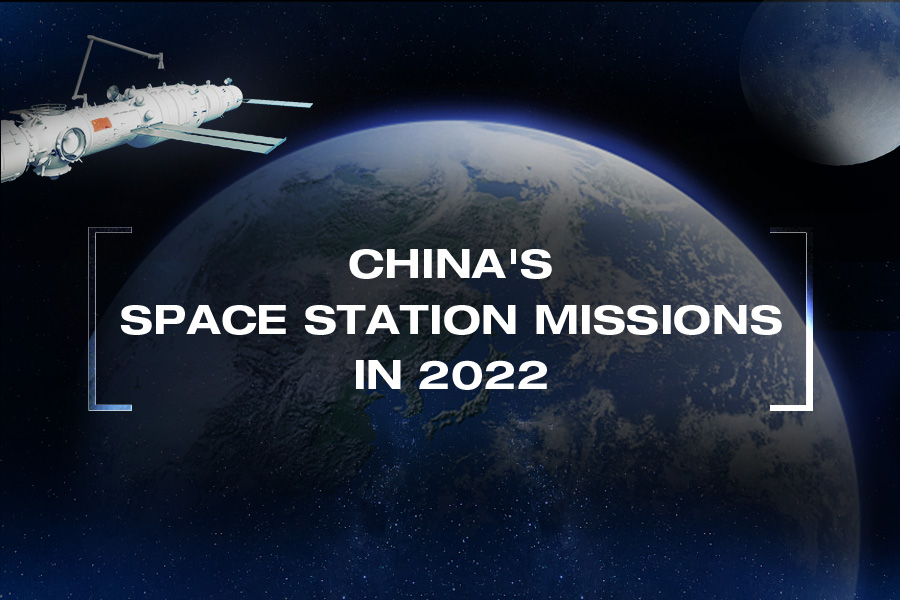
c36f903c-899e-4e53-8622-b4ece6d0c038.png)

